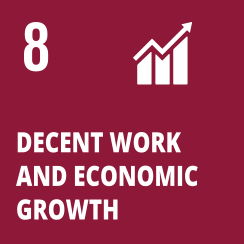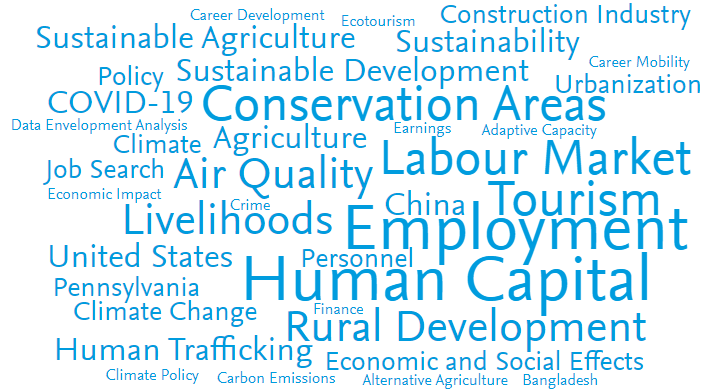
Promote inclusive and sustainable economic growth, full and productive employment and decent work for all
This goal focuses on sustaining per capita economic growth by achieving higher levels of economic productivity through diversification, technological upgrading and innovation; promoting development-oriented policies that support productive activities, decent job creation, entrepreneurship, creativity and innovation; improving global resource efficiency in consumption and production and decoupling economic growth from environmental degradation. It also focuses on the workforce with a focus on achieving full and productive employment and decent work for all; reducing the proportion of youth not in employment, education or training; developing and operationalizing a global strategy for youth employment; eradicating forced labor, modern slavery, human trafficking and child labor; by protecting labor rights and promoting safe and secure working environments. To attain this goal, the capacity of domestic financial institutions must be strengthened to encourage and expand access to banking, insurance and financial services for all and increasing Aid for Trade support for developing countries. It also includes work to devise and implement policies to promote sustainable tourism. Learn more about strategies to attain this goal in the Targets & Indicators section below.

Source: SciVal.com | This word cloud was created using publications from Penn State researchers
Targets & Indicators
Target 8.1: Sustain per capita economic growth in accordance with national circumstances and, in particular, at least 7 per cent gross domestic product growth per annum in the least developed countries
- Indicator 8.1.1: Annual growth rate of real GDP per capita
Target 8.2: Achieve higher levels of economic productivity through diversification, technological upgrading and innovation, including through a focus on high-value added and labor-intensive sectors
- Indicator 8.2.1: Annual growth rate of real GDP per employed person
Target 8.3: Promote development-oriented policies that support productive activities, decent job creation, entrepreneurship, creativity and innovation, and encourage the formalization and growth of micro-, small- and medium-sized enterprises, including through access to financial services
- Indicator 8.3.1: Proportion of informal employment in total employment, by sector and sex
Target 8.4: Improve progressively, through 2030, global resource efficiency in consumption and production and endeavor to decouple economic growth from environmental degradation, in accordance with the 10‑Year Framework of Programs on Sustainable Consumption and Production, with developed countries taking the lead
- Indicator 8.4.1: Material footprint, material footprint per capita, and material footprint per GDP
- Indicator 8.4.2: Domestic material consumption, domestic material consumption per capita, and domestic material consumption per GDP
Target 8.5: By 2030, achieve full and productive employment and decent work for all women and men, including for young people and persons with disabilities, and equal pay for work of equal value
- Indicator 8.5.1: Average hourly earnings of employees, by sex, age, occupation and persons with disabilities
- Indicator 8.5.2: Unemployment rate, by sex, age and persons with disabilities
Target 8.6: By 2020, substantially reduce the proportion of youth not in employment, education or training
- Indicator 8.6.1: Proportion of youth (aged 15–24 years) not in education, employment or training
Target 8.7: Take immediate and effective measures to eradicate forced labor, end modern slavery and human trafficking and secure the prohibition and elimination of the worst forms of child labor, including recruitment and use of child soldiers, and by 2025 end child labor in all its forms
- Indicator 8.7.1: Proportion and number of children aged 5–17 years engaged in child labor, by sex and age
Target 8.8: Protect labor rights and promote safe and secure working environments for all workers, including migrant workers, in particular women migrants, and those in precarious employment
- Indicator 8.8.1: Fatal and non-fatal occupational injuries per 100,000 workers, by sex and migrant status
- Indicator 8.8.2: Level of national compliance with labor rights (freedom of association and collective bargaining) based on International Labor Organization (ILO) textual sources and national legislation, by sex and migrant status
Target 8.9: By 2030, devise and implement policies to promote sustainable tourism that creates jobs and promotes local culture and products
- Indicator 8.9.1: Tourism direct GDP as a proportion of total GDP and in growth rate
Target 8.10: Strengthen the capacity of domestic financial institutions to encourage and expand access to banking, insurance and financial services for all
- Indicator 8.10.1: (a) Number of commercial bank branches per 100,000 adults and (b) number of automated teller machines (ATMs) per 100,000 adults
- Indicator 8.10.2: Proportion of adults (15 years and older) with an account at a bank or other financial institution or with a mobile-money-service provider
Target 8.a: Increase Aid for Trade support for developing countries, in particular least developed countries, including through the Enhanced Integrated Framework for Trade-related Technical Assistance to Least Developed Countries
- Indicator 8.a.1: Aid for Trade commitments and disbursements
Target 8.b: By 2020, develop and operationalize a global strategy for youth employment and implement the Global Jobs Pact of the International Labor Organization
- Indicator 8.b.1: Existence of a developed and operationalized national strategy for youth employment, as a distinct strategy or as part of a national employment strategy







